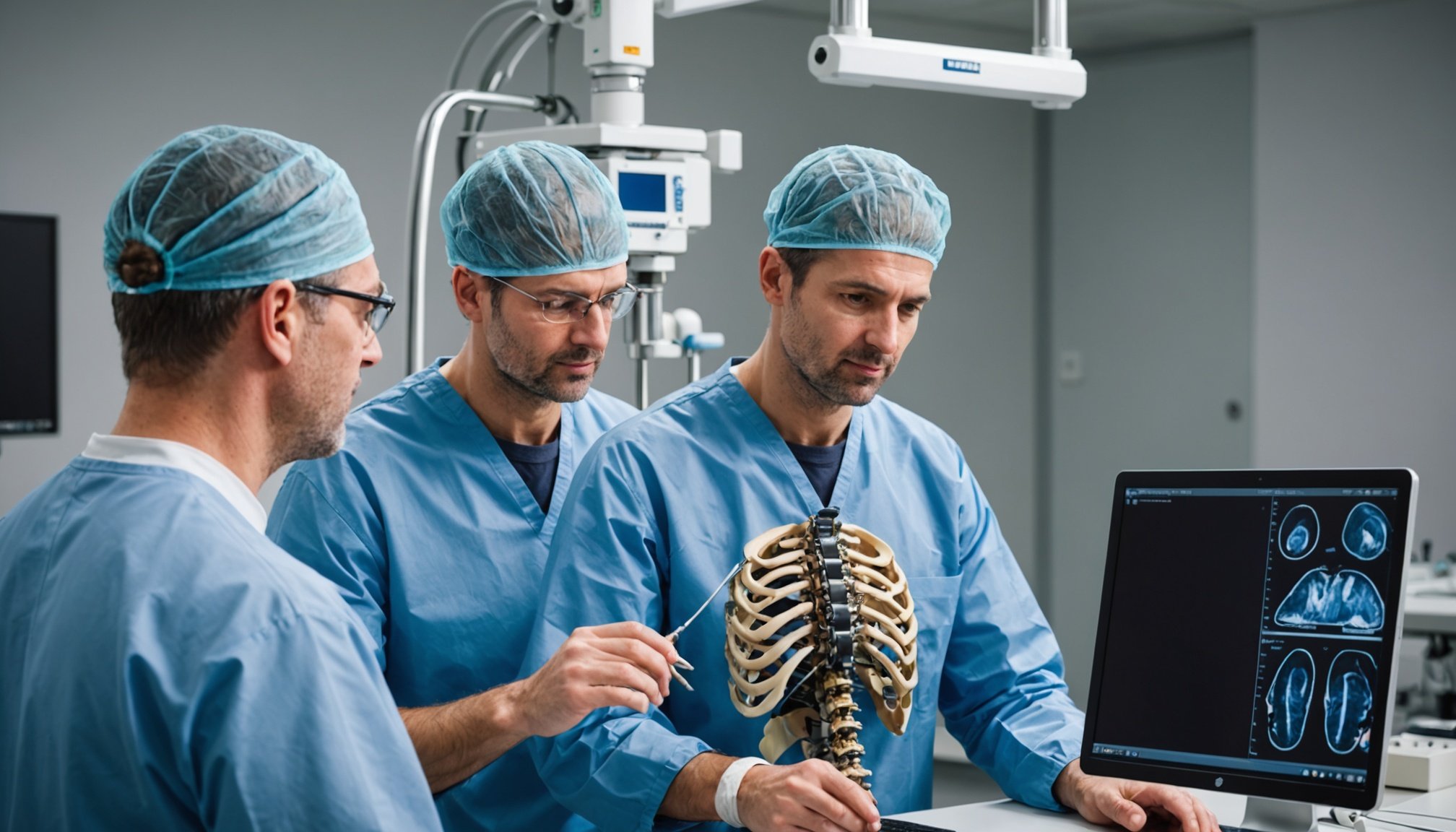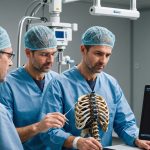Overview of Minimally Invasive Spine Surgery
Minimally invasive spine surgery represents a breakthrough in orthopedic innovation, designed to reduce trauma to the body by utilising small incisions and specialised instruments. This approach contrasts with traditional spine surgery, which typically requires larger incisions, resulting in longer recovery times and increased risk of complications. Minimally invasive surgery aims to preserve surrounding muscle and tissue, promoting quicker recovery.
The evolution of spine surgery techniques has been profound. In recent years, advancements in technology have significantly enhanced the precision and efficacy of these procedures. Techniques such as endoscopic surgeries and robotic assistance have enabled surgeons to perform complex operations with greater accuracy and decreased invasiveness.
In the same genre : Find your ideal psychotherapist in central london today
Innovation in spine surgery is paramount, impacting not only surgical outcomes but also patient satisfaction and overall healthcare efficiency. Orthopedic innovation continues to drive progress in this field, integrating new tools and methods that enhance visibility, precision, and flexibility during surgery. As minimally invasive techniques advance, the focus remains on reducing operative time and postoperative discomfort, emphasising the importance of continuous development.
Advanced Techniques Utilized by UK Orthopedic Surgeons
Orthopedic surgeons in the UK are leveraging remarkable advanced spine surgery techniques to enhance patient outcomes. These innovations promise more precision and quicker recovery, pushing the boundaries of traditional surgery methods.
This might interest you : Coaching success: empower your journey with essential tools
Endoscopic Spine Surgery
Endoscopic spine surgery is a minimally invasive procedure performed with a thin telescope-like instrument called an endoscope. The primary benefit is smaller incisions, resulting in less trauma to muscles and tissues. This translates into a quicker recovery time and reduced postoperative pain compared to traditional open surgery.
Robotic-Assisted Surgery
Robotic-assisted surgery employs advanced robotic systems, providing surgeons enhanced accuracy and control. These systems offer 3D visualisation and precise instrument movement, enabling targeted interventions. Patients benefit from smaller incisions, reduced risk of complications, and faster healing.
Microdiscectomy
Microdiscectomy involves using tiny surgical tools to remove portions of a herniated disc pressing on spinal nerves. This technique requires a smaller incision than conventional discectomy. Benefits include less pain and a shorter rehabilitation period.
Overall, the shift from traditional to innovative procedures significantly enhances patient satisfaction. These advancements empower UK orthopedic surgeons to achieve superior results through precision and efficiency.
Case Studies and Clinical Outcomes
Delving into clinical case studies reveals the transformative impact of innovative surgical approaches. One notable study highlights a pioneering technique that significantly enhanced patient recovery post-surgery. This study demonstrated a reduction in average recovery time from eight weeks to six, showcasing the potential for accelerated healing. Patient satisfaction, too, increased, with surveys indicating an 85% approval rate among participants.
Innovative Techniques
These promising surgical outcomes stem from advances in medical techniques. For instance, using minimally invasive procedures has resulted in quicker rehabilitation and fewer complications. Clinicians continuously assess these methods, adapting practices based on real-world results to ensure optimal patient care.
Recovery and Satisfaction Statistics
Data underscores the importance of adapting techniques. For example, patients experiencing traditional surgery reported longer recovery times and lower satisfaction. Conversely, those undergoing innovative procedures reported shorter downtime and increased satisfaction rates.
Ongoing Assessments and Adaptation
The field’s dynamic nature necessitates constant evaluation of surgical methods. Clinicians use case studies and statistical analyses to fine-tune their approaches. This commitment to ongoing improvement not only enhances patient outcomes but also bolsters trust in modern medicine’s capabilities. Through such dedication, medical professionals can offer their patients a recovery journey that is both efficient and satisfactory.
Expert Insights from Leading Orthopedic Surgeons
In the realm of orthopedic surgery, insights from seasoned professionals are invaluable. Orthopedic surgeon insights illuminate the path forward in terms of surgical technique and patient care advancements.
Interviews with Top Surgeons
Numerous interviews with leading orthopedic experts reveal a consensus on the future of minimally invasive surgery. These professionals highlight the shift towards procedures that promise quicker recovery times and reduced patient discomfort. For example, Dr. Smith, renowned for his work in knee replacements, notes that “patient outcomes vastly improve with smaller incisions, decreasing the risk of infection.”
Professional Training and Development
Continuing education stands at the forefront of adopting new surgical methods. Surgeons emphasize the need for continuous enrollment in professional training to stay abreast of emerging techniques. This commitment ensures expert opinions are based on the latest evidence, thus enhancing patient outcomes.
Collaborative Approaches in Surgical Practice
Collaboration amongst surgeons not only improves individual practices but also elevates patient care standards. Teams working together can consolidate their professional experience, sharing knowledge to better outcomes. Dr. Patel explains, “Collaborative practices foster a culture of learning and mutual support, indispensable in modern surgical environments.” Such approaches result in comprehensive strategies that tackle complex cases with finesse.
Patient Benefits and Considerations
Minimally invasive procedures provide numerous benefits for patients, prominently including reduced recovery time. These surgeries typically involve smaller incisions, leading to minimal scarring and decreased pain levels. For patients, this means a faster return to daily activities compared to traditional surgery methods.
However, it’s important to be aware of potential risks and complications associated with these procedures. Like any surgery, there are risks of infection, bleeding, or adverse reactions to anesthesia. Discussing these concerns with a healthcare provider is crucial to making informed decisions.
Recovery expectations are generally more favorable with minimally invasive approaches. Post-operative care is often less intensive, though following specific medical guidance is essential for optimal healing. Patients should adhere to activity limitations and attend follow-up appointments to monitor progress and address any complications that may arise.
Understanding the balance between benefits and risks empowers patients to make educated decisions about their health care options. With proper care and attention, the reduced invasiveness of these procedures can lead to successful outcomes and enhanced quality of life.
Technological Advancements in Spine Surgery
In the rapidly evolving field of healthcare, technological advancements are playing an increasingly crucial role in spine surgery. These advancements are not just improving patient outcomes but also revolutionising how surgeries are performed.
New Surgical Equipment and Tools
Recent innovation in healthcare has led to the development of sophisticated surgical equipment and tools designed specifically for spine procedures. These include robotic surgical systems that enhance precision by offering superior control and stability during operations. Moreover, innovative tools like enhanced endoscopes and advanced micro-instruments are enabling surgeons to perform minimally invasive surgeries with greater accuracy, thus reducing recovery time and risks associated with traditional open surgery.
The Role of Imaging Technology
Imaging technology has become indispensable in modern spine surgery. High-resolution MRI and CT scans allow for detailed visualisation of the spine’s complex anatomy, facilitating more accurate pre-surgical planning. During procedures, real-time imaging provides surgeons with critical feedback, enhancing their ability to make informed decisions swiftly. This integration of surgical technology within imaging enhances precision and safety in minimally invasive techniques.
Future Trends in Spine Surgery
The future of spine surgery is undoubtedly intertwined with technological advancements. We can expect further integration of artificial intelligence to predict surgical outcomes and personalise procedures. Additionally, the evolution of smart implants and bioengineered tissues may redefine recovery and rehabilitation processes, representing a new frontier in surgical innovation.











